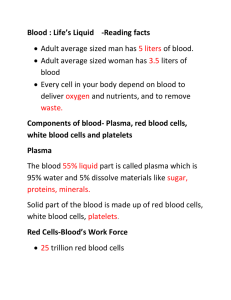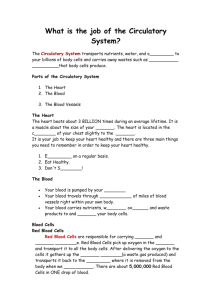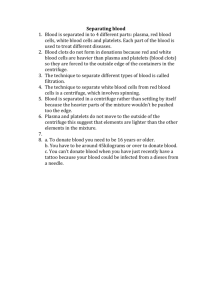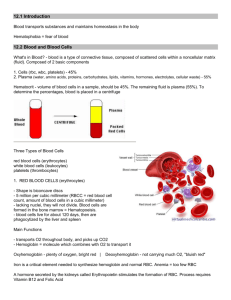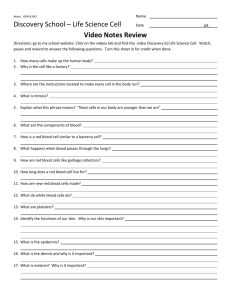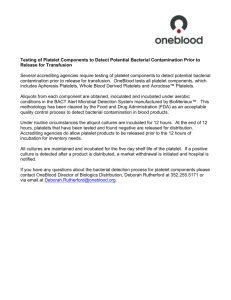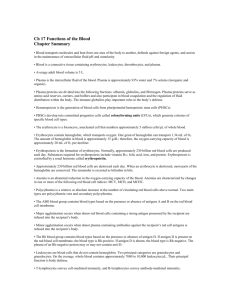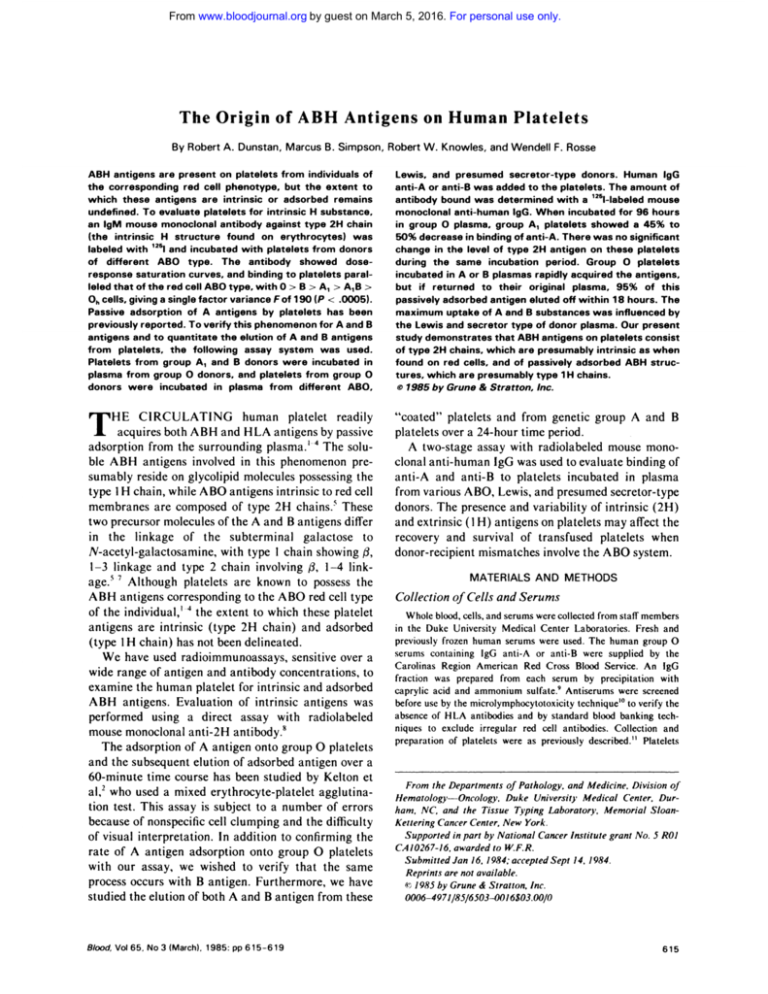
From www.bloodjournal.org by guest on March 5, 2016. For personal use only.
The
By
ABH
antigens
the
are
Robert
present
corresponding
which
antigens
To
1gM
(the
labeled
of
H
with
response
leled
that
and
intrinsic
of the
cell
intrinsic
with
ABO
platelets
binding
type.
with
of
Lewis,
anti-A
was
from
reported.
antigens
and
to quantitate
platelets.
Platelets
the
from
plasma
from
donors
were
HE
To verify
the
A1 and
donors
to platelets
paral-
incubated
but
A and
B
were
in
plasma
from
human
used.
incubated
from
group
different
type I H chain,
while ABO
membranes
are composed
antigens
of type
platelet
57
ABH
type
of the
individual,’4
the
antigens
are intrinsic
(type
1 H chain)
has
We have
wide range
are
The
adsorption
these
(type
2H chain)
not been delineated.
examine
the human
platelet
ABH
antigens.
Evaluation
and the
60-minute
to which
used nadioimmunoassays,
of antigen
and antibody
performed
using
mouse
monoclonal
to
known
to possess
to the ABO red cell
extent
a direct
anti-2H
and
red
over
nadiolabeled
from
various
0 platelets
recovery
and
process
studied
Blood,
wished
to
verify
3 (March),
1985:
pp 6 15-619
95%
of
this
The
influenced
Our
consist
intrinsic
adsorbed
by
present
as when
ABH
struc-
1 H chains.
Lewis,
and
survival
of
the
blood,
Duke
serums
cells,
containing
lgG
Region
fraction
caprylic
prepared
acid
and
the ABO
METHODS
AND
were
serums
were
anti-A
or
ammonium
used.
Blood
serum
sulfate.9
of
HIA
to
antibodies
exclude
preparation
of
and
irregular
platelets
staff
members
Fresh
group
supplied
by
Service.
by
and
human
An
Antiserums
were
by standard
cell
blood
with
screened
banking
antibodies.
as previously
0
the
lgG
precipitation
technique’#{176} to verify
red
were
The
were
Cross
each
from
laboratories.
anti-B
Red
from
collected
Center
use by the microlymphocytotoxicity
absence
when
system.
Serums
American
was
platelets
involve
Medical
human
secretor-type
transfused
and serums
University
frozen
Carolinas
before
and
presumed
variability
of intrinsic
(2H)
on platelets
may affect
the
Collection
described.”
the
techand
Platelets
antigen
over a
by Kelton
et
to confirming
the
group
0 platelets
that
occurs
with B antigen.
Furthermore,
the elution
of both A and B antigen
Vol 65, No
Inc.
of Cells
From
the
CA10267-16.
we
& Stratton,
mismatches
Collection
of visual
interpretation.
In addition
rate of A antigen
adsorption
onto
assay,
type
antigens.
on platelets
passively
MATERIALS
ham.
our
of
platelets
the
1 8 hours.
was
antigens
platelets
0
plasma.
presumably
presence
and
(1 H) antigens
donor-recipient
al,2 who used a mixed
erythrocyte-platelet
agglutination test. This assay
is subject
to a number
of errors
because
of nonspecific
cell clumping
and the difficulty
with
and
plasma.
are
presumably
ABO,
donors.
The
and extrinsic
niques
group
cells,
are
these
off within
ABH
to
no significant
acquired
of donor
hours
“coated”
platelets
and from
genetic
group
A and B
platelets
oven a 24-hour
time period.
A two-stage
assay
with radiolabeled
mouse
monoclonal anti-human
lgG was used to evaluate
binding
of
anti-A
and anti-B
to platelets
incubated
in plasma
in
a
to
which
on
B substances
type
96
a 45%
Group
rapidly
eluted
that
chains.
by Grune
Whole
adsorbed
and adsorbed
antigens
was
assay
with
antibody.8
onto
2H
@ 1985
platelet
sensitive
concentrations,
subsequent
elution
of adsorbed
time course
has been studied
the
type
secretor
demonstrates
previously
for intrinsic
of intrinsic
of A antigen
of A and
and
on
with type I chain
showing
fi,
2 chain
involving
/3, 1-4 link-
Although
platelets
antigens
corresponding
uptake
the
Lewis
antigen
period.
original
maximum
for
was
of
mouse
showed
There
2H
their
antigen
which
differ
to
adsorbed
tures,
readily
B antigens
galactose
returned
found
intrinsic
to med cell
2H chains.5
These
two precursor
molecules
of the A and
in the
linkage
of the
subterminal
N-acetyl-galactosamine,
1-3 linkage
and
if
0
acquires
both ABEl and HLA antigens
by passive
adsorption
from the surrounding
plasma.’4
The soluble ABH
antigens
involved
in this phenomenon
presumably
reside
on glycolipid
molecules
possessing
the
of type
incubation
IgG
amount
a 126l-labeled
incubated
of anti-A.
in A or B plasmas
in
ABO,
with
The
A1 platelets
passively
study
incubated
CIRCULATING
for
level
same
Human
platelets.
When
group
in binding
donors.
to the
lgG.
plasma.
in the
of type
platelets
anti-human
0
the
B antigens
and
determined
during
was
B donors
was
change
system
donors.
bound
decrease
of A and
0
added
group
F. Rosse
secretor-type
was
dose-
phenomenon
assay
presumed
showed
0 > B > A1 > A1B>
elution
following
group
group
this
and
50%
and Wendell
or anti-B
monoclonal
in
Platelets
Knowles,
antibody
chain
erythrocytes)
W.
to
H substance.
2H
on Human
Robert
remains
type
antibody
and
extent
adsorbed
on
The
curves.
individuals
the
against
found
type.
red
or
for
incubated
ABO
previously
T
are
B. Simpson,
giving
a single
factor
variance
Fof 1 90 (P < .0005).
adsorption
of A antigens
by platelets
has been
Passive
from
but
antibody
Antigens
Marcus
from
platelets
saturation
#{176}h
cells,
on
structure
1251
different
Dunstan,
platelets
monoclonal
intrinsic
A.
phenotype.
evaluate
mouse
of ABH
cell
red
these
undefined.
an
Origin
the
same
we have
from these
Departments
of Pathology.
Hematology-Oncology,
NC.
Kettering
and
the
Cancer
Supported
Submitted
Reprints
© I 985
Duke
Tissue
Center.
in part
Jan
Medicine.
Medical
Laboratory.
Division
Center.
Memorial
of
Dur-
Sloan-
York.
by National
awarded
are
Typing
New
and
University
Cancer
institute
grant
No.
5 ROl
to W.F.R.
16. 1984;
accepted
Sept
14, 1984.
not available.
by Grune
& Stratton,
Inc.
0006-4971/85/6503--0016$03.OO/O
615
From www.bloodjournal.org by guest on March 5, 2016. For personal use only.
616
DUNSTAN
from
a donor
of the
Red Cross
#{176}h
(Buffalo,
(CPD-Al)
and tested
lation
and
storage
antibody
within
results
platelets
citrate
24 hours
when
platelets
collected
mixture
dextrose-adenine
Scientific
Co,
CPD-anticoagu-
phthalate
[Eastman
optimal
be
collected
significantly
by the American
of collection.
cannot
platelets
not
supplied
phosphate
20 #{176}C
is considered
0 one-day-old
gave
were
in
at
assays
Group
blood group
NY)
in
different
for
platelet
tested
immediately.’2
the same
anticoagulant
from
those
of
tion
of
off.
0
in EDTA.
Each
Kodak
platelet
Purification
and
Radiolabeling
of Monoclonal
were
calculated
using
r
monoclonal
laboratories
Inc.
and radiolabeled
Mouse
was
eluted
(0.1
sodium
by
other
proteins
by sodium
was preserved
radiolabeled
monoclonal
2H
Equal
anti-type
NaCI,
and
purity
was
were
2H
The
thawed
anti-type
for use
(GVB-EDTA)
30
antibody,
using
on platelets,
from
different
of platelets
l)
minutes
was performed
at
with
beginning
of
from
group
ABO
and
500
2sI
Mg/mI
2H
dilutions
of the
at a concetration
of
diamine
acid
tetracetic
at 22 #{176}C
for 30 minutes.
platelets
a
of
22 #{176}C.
Anti-type
doubling
buffer-ethylene
and incubated
conducted
(100
0,
A,,
2
lncubations
B, A,B,
and
#{176}h
blood type donors.
For
the adsorption-elution
was incubated
for varying
at room
temperature.
evaluated
by mixing
time
plasma,
studies
group
done
to
incubation
at
levels
incubations.
EDTA
The
and
minutes
100
‘25l-labeled
After
were
the
higher
were
pipetted
platelets
or
22 #{176}C
gave
equivalent
were
then
After
three
suspension
anti-human
incubation
separate
in
lgG
both
resuspended
400-mb
more
with
A,
results,
the
and
microfuge
and
in GVBfor
tubes
The
of 1.65
specific
over
bound
(Figs
x l0
a wide
per cell”
I and
to cells
of experiments,
.0005),
test
differences
different
also
2)
exposed
each
r,
molar
n is
sample
concen-
daltons.’3
range
refers
and
This
of antigen
to the binding
to
to lgG
the
of
binding
anti-A
the reactivity
paralleled
phenotype
gave an
while
analysis
demonstrated
in type 2H
ABO
types.
of
or anti-B
of anti-type
that
predicted
(Fig 1). SingleF value
of 190
by Student-Newmanstatistically
significant
antigen
strength
The strength
of
on platelets
the type
of
2H
antigen
on platelets
corresponds
to the emythnocyte
pattern
ofO > B > A > A1B > #{176}h phenotypes57
and is
unaffected
by the Lewis
and
secretor
type
of the
platelet
donor.
Dose-response
curves
with anti-type
2H
against
0, A,, and B platelets
demonstrate
that
the
type 2H
(Fig 2).
Group
structure
0
is a saturable
platelets
receptor
incubated
A on B antigen
during
the first
with
reactivity,
hour
and
on platelets
A on B plasma
which
increases
then
more
slowly
.
1
25
#{149}
:
Jo
S
I
30
5
in GVB100 ml
of
I
0
50-Mb
counts.
weight
from
back-
times
two-stage
three
of the ligand,
15
for 30 minutes.
one-
background
IgG
2O
for all
or anti-B
with
mole
of the tips
or B
Although
washes
was incubated
each
per cell,
5).
30
passively
anti-B.
three
anti-A
bound
x C,,,r,/(n)(S,,A),
is the cpm
and
2H
For these
22 #{176}C
was used
washed
200 Ml of IgG
of lgG
(PackFor
elution
had
absorbed
minute.
was
identical
that
anti-A
with
thoroughly
into
<
B plasma
in A, or B plasmas.
was repeatedly
temperature.
final
while
at 37 #{176}C;
therefore,
ILl of platelet
the
0
A, and
one
in cpm/m
2H antibody
with platelets
for red cells of the same
factor
analysis
of variance
B antigens
from platelets
group A, and B donors in
plasma,
group
or buffer
B substances
group
detectable
platelets
monoclonal
with
by incubation
all
incubated
at room
EDTA,
platelets
autologous
37 #{176}C
and
were
3 through
acquire
rapidly
suspension
of plasma
A and
loss of A and
platelets
from
0 plasma
remove
in I ml
of soluble
0 platelets
using
the group
cells
ground
and
A or B antigens
studies,
red
buffer,
were
acquired
periods
Uptake
of known
lewis
phenotypes.
was measured
by suspending
0
200 Mb of platelet
studies,
C(,,)
“molecules
anti-human
(P
the binding
at a concentration
for
2H
present
to compare
‘25I-labeled
counter
concentrations.’4
In a series
lgG.
to platelets
antibody
analysis
2H antigen
x 1020)
is sensitive
‘251-labeled
The
(SDS)-PAGE.
that
unbound
RESULTS
contamination
anti-human
volumes
in gelatin-veronal
were
sulfate
was used
antibody
together
dose-response
mg/mb
system
donors.
incubated
labeled
of type
assay
anti-type
blood group
were
5%)
for
molecules
activity
on a molecular
anti-type
(Figs
(6.02
and
‘251-labeled
Keulls
the quantity
(one-stage)
labeled
and
system
of
to
was cut
with
Assay
To measure
direct
8.0) and
(PAGE).
than
fractions
as for the monoclonal
Radioimmune
mol/l
pooled
assay
centrifuga-
was applied
the formula:
for the tube
is based
In the figures,
was
G-200
electrophoresis
(less
dodecyl
in frozen
(pH
of cells
correction
tration
-
After
scintillation
Ill)
tested,
is the specific
and antibody
at pH
(DEAE)
HCI
0.15
was
protein
Sephadex
were
gel
(all
SA
the number
in distilled
The
TRIS
on
minor
fluid
fluid
dissolved
TRIS-HCI,
contained
of ascites
buffer.
mol/l
Fractions
polyacrylamide
antibody
antibody
mol/b
azide).
where
antigen8
aminoethyl
same
in 0.01
ascites
in TRIS-HCI
to a diethyl
chromatography
buffer
mol/l
purified
KCI
2 ml
sulfate,
in the
from
2H erythrocyte
60 hours
applied
Research
after
type
as follows:
equilibrated
before
determined
and
was
(Bethesda
was purified
ammonium
in 0.2 mol/b
TRIS-NaCI
0.005
fluid
at 4 #{176}C
for
dialysate
(Fc)
anti-human
ascites
column
concentrated
with
described.”
1gM
dialyzed
The
cellulose
then
as previously
in saturated
and
8.0).
Md)
from
precipitated
lgG
Gaithersburg,
monoclonal
purified
water,
anti-human
Grove,
[Fisher
the tip of the tube
free
gamma
AL
[2-ethylhexyl]
a clamp
and
tip,
bis
NY]).
microfuge,
in the
phthalate
part
Rochester,
in a well
reaction
Antibodies
Mouse
Co.
I .0
of the oil layer,
Downers
n-butyl
and
Calif)
button
antibody-platelet
parts
NJ]
(Irvine,
was counted
Tri-carb,
(1.5
lawn,
in the middle
anti-lgG,
ard
esters
Fair
in a Beckman
the tube
group
phthalate
ET
I
B
Plom
580
I
I
I
I,
AG
0h
Type
assays,
volumes
containing
a
Fig 1 .
Binding of ‘251-labeled
anti-type
from 0. B. A,. A,B. and 0h donors.
2H antibody
to platelets
From www.bloodjournal.org by guest on March 5, 2016. For personal use only.
ABH
ANTIGENS
617
ON PLATELETS
0
0
4H
-
5
of Antibody
Concentration
Fig 2.
anti-type
Dose-response
curves
2H antibody
to platelets
from
one
incubated
activity.
plasma
incubated
to 24 hours
in 0 plasma
for the binding
of ‘25I-labeled
from 0. B. and A, donors.
(Fig 3). Group
on buffer
show
0 platelets
no A or B
their passively
acquired
A or B antigen
within
18 hours
(Fig 3).
Group
A on B platelets
maintained
in A on B
plasma,
respectively,
show no change
in A on B antigen
over
24 hours,
in buffer or absorbed
in reactivity
during
but
A1 or B platelets
0 plasma
demonstrate
the same
period.
incubated
a decrease
Most
of this
elution
occurs
in the first five hours of incubation,
and
by 24 hours,
group
A on B platelets
still retain
significant reactivity
as compared
with the essentially
complete
loss of antigens
passively
acquired
on genetic
group
0 platelets
(Fig 4). On two occasions
we have
extended
this
incubation
of group
A1 platelets
plasma
to four days with daily changes
maximum
loss of 45% to 50% of A antigen
in group
0 plasma
(Fig 4).
theme
was
no significant
change
level
2H
antigen
group
A, platelets
present
(dotted
line,
Fig 4), as measured
a one-stage
nadioimmunoassay
(RIA).
To determine
the effect
of plasma
donor
status
on the absorption
of A and B antigens
platelets,
24 hours
donors
by
secretor
on to 0
the platelet
suspensions
were incubated
for
in A and B plasma
from known
Lewis-type
(Fig
5).
The
difference
among
the
groups
is
significant
when
analyzed
by Knuskall-Wallis
test,
although
the difference
between
the Le(a+b-)
and
Le(a-b+)
groups
for A absorption
is not significant
when
analyzed
by a Wilcoxon
two-sample
test. The
10
in 0
two days
experiments
of type
Fig 4.
Elution
of A antigen
from group
A,. Le (a - b + ) platelets
over 96 hours with a change
of plasma/buffer
every
24 hours.
Platelets
from a group A, donors
(0) were
incubated
in group 0
plasma
(rJ). autologous
group A, plasma
(0), or buffer
(Lu). The
level of type
2H antigen
on the same
group
A platelets
is
essentially
unchanged
over the same time period (s).
of plasma.
A
was reached
in approximately
In the same
in the
96
48
Time (Hours)
I mg/rn))
Group
0 platelets
incubated
with
A on B
for five hours,
washed
three
times,
and then
in their
own original
plasma
lose 95% of
strength
I
2429
on the
8
C-)
.
8
.
0
6
I2
±4
0
B
2
--------------------------------:;
Trne I Hu’
1
I
Le(c+b-)
Fig 3.
Adsorption
of A antigen
onto group 0 platelets
over a
24-hour
time period. Group 0 platelets
were incubated
in group A,
Ic (a - b + ) plasma
(0). autologous
group 0 plasma
(0), or buffer
(a). Group 0 platelets
incubated
in group A, plasma for five hours.
washed
three
times
in buffer,
and then incubated
in group
0
plasma lose most of their acquired
antigen
(dotted
line).
Plasma
I
Le(a-b+)
I
Le(a-b-)
Lewis Type
Fig 5.
Molecules
of ‘25l-labeled
anti-lgG
bound
by group
0
platelets
that were exposed
for 24 hours to plasma from group A
(#{149})
and B (0) donors
of different
Lewis
phenotypes
and then
incubated
with anti-A or anti-B.
From www.bloodjournal.org by guest on March 5, 2016. For personal use only.
618
DUNSTAN
Le(a
b
-
)
-
plasma
donors
However,
absorption
status.
tigen
Le(a+b-)se
not
Le(a-b-)se
>
Kelton
were
the data suggest
for Le(a-b-)Se
tested
for secretor
antigen
a pattern
of A an>
Le(a-b+)Se
>
as found
previously
by
et al.2
present
50% to 55%
2H chains,
found
platelets
possess
to the ABO
blood
emythrocytes.’
These
adversely
affect
platelets
trates
if group
from
group
response
to ABO
and
anti-B
in the
recipients
and
and
secretor
survival
in the plasma.2
passive
platelets,
partly
to
antigen
The
on platelets
major
blood
and
in the
donor,
The
by
and
the
on the platelet
type A substance
studies
is attached
have
evaluated
assessed.
are trans-
by red cell precursors
as
some and perhaps
all ABH
antigen
from
inversely
occur
as pas-
with
plasma
consists
of
H antigen
serves
as
the strength
of H
the
antibody
has
been
amount
Our
of A or
B
show
characterized
2 configuration
assays
using
dose-response
saturation
of
this
that the human
platelet
of the ABH system.
studies
curves
variability
in strength
as an inverse
conversion,
with H-negative
(Oh)
agree
with
those
possesses
of previous
intnin-
workers
on
the passive
uptake
of soluble
A antigen,
which
is
probably
a type
1 structure.2’3
Using
the sensitive
RIA,’4
we have extended
these observations
to include
the adsorption
and elution
of both A and B antigens
on
group
0 platelets,
which
is affected
quantitatively
by
pletely
enythrocytes
is synthesized
type
2 glycolipids,
whereas
type I glycolipid.57
Because
the
precursor
for A and B antigens,
2H
as specific
for the type
med cell H antigen.8
Direct
the Lewis
Furthermore,
to the oligosacchar-
the
anti-type
demonstrate
sic antigens
is
the precursor
H antigen
and the derived
A and B
antigens
exist either
as type
I or type 2 chains.5’7
In
group
A or B individuals,
most of the A or B antigen
on
varies
remainder
demonstrati
ng essentially
no reactivity
above
assay
background
values.
If the platelet
and
are assumed
to be analogous
with respect
to
of type
2H structures,
then
our findings
be due
anti-A
backbone
by N-acetylglucosamine.
This
linkage
between
$-D-galactose
and N-acetylglucosamine
occurs in two forms,
a /3(1-3)
linkage
designated
type I
chain and a /3(1-4)
linkage
termed
type 2 chain.
Thus
reactivity
the
platelets
indirect
med cell
derivation
may
B substances
from plasma
of intrinsic
A and B
acquired
and
2H
ide
passively
antigens
on platelets
occur as type
are presumably
intrinsic,
as when
predicted
ofsubstnate
has not been previously
group
ABH
antigens
fl-D-galactose
struc-
anti-type
and D-galactose
(B antigen)
are attached
in a fl(l-3)
linkage
to the
H determinant,
which
consists
of
fl-D-galactose
with an 1-fucose
at its two-carbon
posiThe
ABH
2 chain.57
that approximately
and the
function
platelets.
is affected
the
1gM
ferase-specified
oligosacchanide
determinants
on glycoproteins
or glycolipids.57
The terminal
immunodeterminant
sugars
N-acetyl-galactosamine
(A antigen)
tion.
ofABH
which
med cells,
previously
intrinsic
can
to differences
of
earlier
of A and
contributions
intrinsic
of transfused
on donor
on platelets
type
Although
uptake
the
with
platelet
concenVariability
of
of immune
amount
of blood group
A substance
proportional
to the amount
of soluble
the
antigens
platelets
in titer
of A or B antigen
of A or B reactivity
Lewis
group
patients
receive
A or B donons.24
incompatible
to differences
the
0
B antigens
comeof the individual’s
blood
the recovery
partly
amount
strength
A and
group
major
on
cell,
sively adsorbed
structures,
which
are presumably
type
I H chains
ofsoluble
glycolipid.
The mouse
monoclonal
DISCUSSION
Human
sponding
on the
of the fl(] -4) type
study demonstrates
tunes composed
Our present
ET AL
and
this
secretor
rapid
reversible
by
type
passive
of
returning
the
uptake
the
donor
plasma.
appears
corn-
platelets
to
their
original
0 plasma,
indicating
the gradual
loss of the
acquired
A substance,
presumably
owing
to elution
from
the platelet
into
the suspending
plasma.
By
contrast,
slightly
similar
tion
platelets
from
genetic
A on B donors
less than half their reactivity
when subjected
incubations,
suggesting
that a significant
lost
to
por-
of their A or B antigens
is intrinsic
to the cell.
These
data
suggest
that
the ABH
antigens
on
human
platelets
2H) and extrinsic
are a mixture
of both
(type
I H) substances.
the
both
quantity
of
may affect
transfusions,
enies and distinct
patients.2’4
Further
ical characterization
assessment
antigens
adsorbed
the outcome
accounting
and
of ABO
for the
intrinsic
(type
Variations
in
intrinsic
antigen
incompatible
platelet
irregular
initial
recov-
biphasic
survival
curves
seen in some
work is needed
for precise
biochemof platelet
ABH antigens
and for
of the
in platelet
significance
transfusion
of intrinsic
therapy.
v adsorbed
REFERENCES
I . M#{225}jskyA: Antigenicity
biol
Immunol
2.
Kelton
blood group
the plasma.
3. Lewis
58:138,
JG,
Hamid
A substance
Blood
JH,
A and B group
of blood
platelets.
Current
Top
4.
Micro-
59:980,
Draude
substances.
C, Aker
S. Blajchman
on platelets
MA:
is proportional
Vox Sang
Coatingof”0”
5:434,
1968
Effect
of anticoagulant
amount
of
in
and
The
P blood
6. Rege
Wi:
RH:
to the amount
1982
J, Kuhns
Aster
on recovery
of transfused
human
5, Watkins
WM:
Biochemistry
1969
platelets
with
of
group
VP,
serologically
human
blood
systems.
Painter
active
group
Adv
Ti,
and
incompatibility
Hum
Watkins
Genet
WM,
fucose-containing
H substance.
ABO
platelets.
Blood 26:732,
1965
and genetics
of the ABO,
Lewis,
Nature
10:1,
Morgan
1980
WTJ:
oligosaccharides
203:360,
1964
Isolation
from
From www.bloodjournal.org by guest on March 5, 2016. For personal use only.
ABH
ANTIGENS
ON
7. Crookston
PLATELETS
MC:
ma, in SandIer
SG,
Blood
8.
Knowles
anti-type
blood group
9.
Ross
JA,
C3
bovine
GD,
Newman
Daniels
fragments
KD,
for
factor
Mickey
cytotoxicity
test.
Liss,
JD,
different
H,
I 58:334,
MR.
Singal
on
p 99
W:
human
A and
B
MB,
absence
antigens.
I 2. Gibbons
lant
JE,
fragments
Cain
of bound
of binding
compelment
Simpson
Rosse
of
Transfusion
WF:
Rhesus,
24:243,
Erythrocyte
Duffy,
antigens
Kell,
Kidd
and
1984
Monoclonal
of the
location
RA,
platelets,
lutheran
Devery-Pocius
sites
receptors
in
and
solution
ment
JG:
storage
of platelet-associated
I 3. Segal
omers
1977
5, Kelton
for
of lgG
DM,
of the optimal
blood
lgG.
Transfusion
Hurwitz
to cells
Assessment
of whole
E: Binding
bearing
samples
22:295,
of affinity
Fe receptors.
prior
anticoaguto measure-
1982
cross-linked
J lmmunol
olig-
1 18:1338,
1983
DP,
Terasaki
Refinement
Transplantation
I I . Dunstan
the plas-
lmmunobiol-
1982
lambris
B and
1980,
Watkins
of three
II.
from
(eds):
a precursor
Med
XVIII.
MS
9:69,
I or serum.
J Exp
acquired
Gb,
detecting
SI,
factor
conglutinin.
AR.
J lmmunogen
homotransplantation.
phocyte
Y,
York,
PJ: Generation
purified
lO.Mittal
for
Bai
antibody
antigens.
lachman
C3 with
the
An
antigens
i, Schanfield
New
RW,
2H:
group
Nusbacher
ogy of the Erythrocyte.
619
P1: Serotyping
of microdroplet
6:913,
1968
lym-
14.
Rosse
lin G-binding
globulin
WF,
Devine
ligands
G. J CIin
with
Invest
DV,
Ware
platelets
73:489,
R: Reactions
of immunoglobu-
and platelet-associated
1984
immuno-
From www.bloodjournal.org by guest on March 5, 2016. For personal use only.
1985 65: 615-619
The origin of ABH antigens on human platelets
RA Dunstan, MB Simpson, RW Knowles and WF Rosse
Updated information and services can be found at:
http://www.bloodjournal.org/content/65/3/615.full.html
Articles on similar topics can be found in the following Blood collections
Information about reproducing this article in parts or in its entirety may be found online at:
http://www.bloodjournal.org/site/misc/rights.xhtml#repub_requests
Information about ordering reprints may be found online at:
http://www.bloodjournal.org/site/misc/rights.xhtml#reprints
Information about subscriptions and ASH membership may be found online at:
http://www.bloodjournal.org/site/subscriptions/index.xhtml
Blood (print ISSN 0006-4971, online ISSN 1528-0020), is published weekly by the American Society of
Hematology, 2021 L St, NW, Suite 900, Washington DC 20036.
Copyright 2011 by The American Society of Hematology; all rights reserved.

